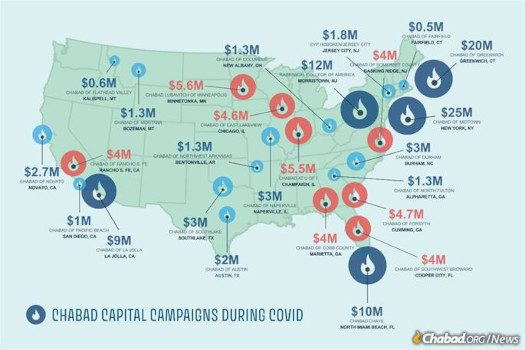
Bucking Trends, $100 Million in Capital Campaigns Highlight Chabad’s Continued Growth
by Mendel Super – chabad.org
When the world entered the Covid era in early 2020, life moved online fast. At first, it all seemed temporary; then Covid’s long-term impact became clearer. Through 2020 and into 2021, almost every facet of Jewish community life became available online, and many questioned what the post-Covid Jewish communal future would look like. Pundits asserted that many had become comfortable “Zooming-in” from home and simply wouldn’t return to brick-and-mortar synagogues and community centers. But Chabad took a different tack. In the past 19 months, Chabad-Lubavitch centers in the United States alone have launched more than $100 million in capital campaigns, pushing forward with hundreds of new centers and expanding or renovating existing ones.
This optimistic outlook builds on a growth pattern that’s been happening for decades. A 2020 study by urban and societal trends experts Joel Kotkin and Edward Heyman shows that amid a nationwide, universal decline in the number of synagogues since the 2001 U.S. Synagogue Census—a 29 percent drop—Chabad has been an outlier, experiencing threefold growth. During the same time frame, they found that the number of Chabad synagogues in the United States had gone from 346 to 1,036 with centers now in all 50 states—this number excluding Chabad on Campus chapters, mikvahs, schools, youth centers and Chabad Young Professional communities.
“When Covid started, you already had a trajectory, which to a certain extent, carried Chabad forward and exacerbated the declines that the other movements were experiencing,” Heyman explained in an interview with Chabad.org.
The physical centers reflect Chabad’s interpersonal engagement: Pew Research Center’s 2021 study of Jewish American life finds that two-in-five Jewish adults (38 percent, or 2.2 million people) report engaging with Chabad-Lubavitch (16 percent of those polled participate “often” or “sometimes,” 21 percent reported participating “rarely”). The Pew data also shows that Chabad attracts a diverse population—more than half of all participants personally identify as Reform, Conservative or unaffiliated. A more detailed 2014 Miami Jewish community study echoed the nationwide trend, finding that 50 percent of Jews under 36 were active with Chabad.
This trend of increasing engagement with Chabad only accelerated during the Covid pandemic. As early as March, 2020, when shops, offices and restaurants were beginning to shut their doors—some permanently—and synagogues were canceling in-person services and classes, Chabad centers started adapting quickly, utilizing their decades of experience pioneering Jewish life on the internet. Tens of thousands of children began logging on to Chabad Hebrew schools, and Chabad rabbis and rebbetzins offered a steady stream of online classes and kids activities, using their creativity to improvise virtual twists of anything that didn’t require in-person gatherings.
Read More at chabad.org













